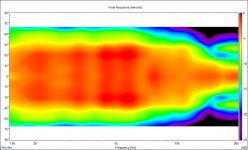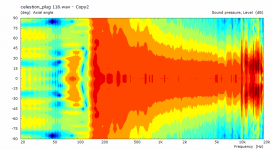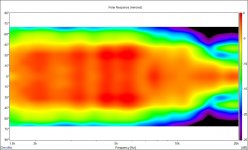Sorry Chris, that came off wrong.
I have been struggling to make a my Axi's not beam for a while and have tried a variety of different things.
I'm happy if it works, and just wanted to know how well..
I have been struggling to make a my Axi's not beam for a while and have tried a variety of different things.
I'm happy if it works, and just wanted to know how well..
No problem. I've become a bit sensitized on this forum. The origin of the lens itself as you might know can be found here: A Visit with Chief Bonehead and The Jubilee. It was developed for use with the Celestion Axi2050 in the new "Heritage Jubilee" that Klipsch finally start producing in May 2022. Roy calls it a "phase plug extension" because its annular rings match the output phase plug annular channels of the Axi2050--which extend all the way to the exit plane of the driver.
For my use, it's really a throat-mounted horn diverging lens since the TD-4002's phase plug exit is inches away from the horn throat entrance plane. I found that the device works as a lens, too, and that it works with virtually any 2" compression driver...some better than others. I recommend its use in all 2" compression driver applications where the compression driver is used full range above 6.8 kHz.
I don't produce the lenses, but I believe you can still acquire them from another diyAudio member. They are worth the money based on my own subjective experience with the TD-4002 and the BMS 4592 ND.
Chris
For my use, it's really a throat-mounted horn diverging lens since the TD-4002's phase plug exit is inches away from the horn throat entrance plane. I found that the device works as a lens, too, and that it works with virtually any 2" compression driver...some better than others. I recommend its use in all 2" compression driver applications where the compression driver is used full range above 6.8 kHz.
I don't produce the lenses, but I believe you can still acquire them from another diyAudio member. They are worth the money based on my own subjective experience with the TD-4002 and the BMS 4592 ND.
Chris
I tried doing something similar, but extended it a couple of inches, which resulted in some combing.
Probably should have kept it short.
Thanks for the heads up!
Here is the discussion on Marcel's ATH thread:
https://www.diyaudio.com/community/...-design-the-easy-way-ath4.338806/post-6906567
And here is the directivity plot measured in an anechoic chamber. (Ø 38cm Controlled Directivity Axi-Symmetric horn with a built in plug)
Probably should have kept it short.
Thanks for the heads up!
Here is the discussion on Marcel's ATH thread:
https://www.diyaudio.com/community/...-design-the-easy-way-ath4.338806/post-6906567
And here is the directivity plot measured in an anechoic chamber. (Ø 38cm Controlled Directivity Axi-Symmetric horn with a built in plug)
Attachments
Last edited:
Ahem...that's "prior art" (in the patent sense). That would negate any patent application that occurred within the past year or so. Bravo.
For those that haven't seen the throat diverging lens (that someone else called a "phase plug extension" and yet someone else called an "external shaping plug" or ESP), here it is:

Here is what the ones I use look like:
![2_Inch_Phase_Extender_Small[1].jpg 2_Inch_Phase_Extender_Small[1].jpg](https://www.diyaudio.com/community/attachments/2_inch_phase_extender_small-1-jpg.1121046/)
Chris
For those that haven't seen the throat diverging lens (that someone else called a "phase plug extension" and yet someone else called an "external shaping plug" or ESP), here it is:
Here is what the ones I use look like:
Chris
I did a BEM simulation of the "throat diverging lens" and it made virtually no difference: https://www.diyaudio.com/community/...-design-the-easy-way-ath4.338806/post-7077667
I would be surprised if it did anything else in a real case. The ESP is actually quite different thing - it actually do something at least in the simulations.
I would be surprised if it did anything else in a real case. The ESP is actually quite different thing - it actually do something at least in the simulations.
ESP is a little bit more complicated:
https://www.diyaudio.com/community/attachments/s25-3-10-jpg.1002096/
https://www.diyaudio.com/community/...-design-the-easy-way-ath4.338806/post-6858421
Here's a summary - https://at-horns.eu/release/Ath-AP1.pdf
https://www.diyaudio.com/community/attachments/s25-3-10-jpg.1002096/
https://www.diyaudio.com/community/...-design-the-easy-way-ath4.338806/post-6858421
Here's a summary - https://at-horns.eu/release/Ath-AP1.pdf
Thanks. Your "ESP" concept looks like part of the Axi2050's phase plug design by Jack Oclee-Brown (EP 2011365B1). That's an actual "phase plug extension" if it matches the output phase plug geometry of the Axi2050.
I wonder why the Klipsch lens seems to work...? My ears (subjectively) and the polar measurements (objectively) tell me that it does...up to 14 kHz. Could it be that it's not actually a phase plug extension, but an acoustic lens that's doing something else?
Chris
I wonder why the Klipsch lens seems to work...? My ears (subjectively) and the polar measurements (objectively) tell me that it does...up to 14 kHz. Could it be that it's not actually a phase plug extension, but an acoustic lens that's doing something else?
Chris
I don't know, I have yet to see an objective data showing that it actually does something.
- The whole aim of the current ESP design is to convert a flat wavefront into spherical. The closer is the actual exit wavefront to flat, the better it should work. The details of a preceding phasing plug haven't been considered (maybe they should but that's a whole different level of complexity).
- The whole aim of the current ESP design is to convert a flat wavefront into spherical. The closer is the actual exit wavefront to flat, the better it should work. The details of a preceding phasing plug haven't been considered (maybe they should but that's a whole different level of complexity).
Last edited:
This is how the The Axi2050 measures on a pretty big OSSE horn with no plug.
Red is on axis, blue is 30 degrees off. The level is probably shifted (can't remember)

And this is how a BMS4550 measures on a 50% scaled version of the same horn.
Red is on axis, blue 22 degrees degrees, green is 33 degrees off.

Not sure how much of a valid comparison this is.
When listening to the axi , one could easily notice the change in tone when moving off axis.
On the 4550 - not so much, even though the graphs seem very similar.
I think the built in phase plug of the Axi2050 makes it behave less like an ideal 2" source which on simulations shows really strong beaming.
Red is on axis, blue is 30 degrees off. The level is probably shifted (can't remember)
And this is how a BMS4550 measures on a 50% scaled version of the same horn.
Red is on axis, blue 22 degrees degrees, green is 33 degrees off.
Not sure how much of a valid comparison this is.
When listening to the axi , one could easily notice the change in tone when moving off axis.
On the 4550 - not so much, even though the graphs seem very similar.
I think the built in phase plug of the Axi2050 makes it behave less like an ideal 2" source which on simulations shows really strong beaming.
I did a BEM simulation of the "throat diverging lens" and it made virtually no difference: https://www.diyaudio.com/community/...-design-the-easy-way-ath4.338806/post-7077667
I would be surprised if it did anything else in a real case.
Clearly, my measurements apparently don't rate with your opinions, (nor does apparently anything that cannot easily be shown by boundary element method modeling of the type that you use). But you took the time to denigrate actual measurements (backed up by subjective listening). Interesting.I have yet to see an objective data showing that it actually does something.
I guess I don't see the reason to worry about opinions if someone hasn't taken the time to use it in a real 2" horn/driver configuration. (This must be the result of some sort of cultural difference where simulation trumps actual measurements.)
____________________________________________________________
That corresponds with my experience with the Axi-2050 on a K-402 horn, one-to-one--that downslope of the 30 degree off-axis SPL response starting at ~6-7 kHz. While unfortunately I didn't record the measurements off-axis (in my search to find the proper vertical on- or off-axis microphone position), I found that I had to basically get on-axis of the horn/driver centerline to keep from experiencing a significant downslope of SPL above 6.8 kHz.This is how the The Axi2050 measures on a pretty big OSSE horn with no plug.
Red is on axis, blue is 30 degrees off. The level is probably shifted (can't remember)

I also noticed that the right-side Axi2050/K-402 didn't subjectively have the same subjective level of "sparkle" as the TD-4002 on the left loudspeaker, even after I adjusted the EQ to result in flat on-axis response with the Axi2050/K-402. Apparently, the issue with the Axi2050 polar beaming must be more severe than the TD-4002. That would say to me that some assumptions on exiting acoustic wavefront shape (i.e., planar or spherical) from the Axi2050 must not be valid.
Note that I received the third-party throat lens after I had returned the Axi2050 to its owner (the driver was kindly on loan for my determination of appropriate PEQs, etc. to be used on a K-402 horn), so I didn't have the opportunity to measure the results off-axis with that particular driver with the lens in the throat of the horn.
Looking at the measurements with the TD-4002/lens combination, I would guess that the lens would help the Axi2050 off-axis performance above 6.8 kHz quite a bit--even though the underlying physics of the "why" remains to be explained.
Chris
Then I must have missed those measurements - those that would show that there's a significant difference with and without the plug. It would be great if there was a difference (for the better of course) - it would be a simple solution to a tough problem that many try to solve. But I still see no reason not to be sceptical, I'm sorry.Clearly, my measurements apparently don't rate with your opinions, (nor does apparently anything that cannot easily be shown by boundary element method modeling of the type that you use). But you took the time to denigrate actual measurements (backed up by subjective listening). Interesting.
Last edited:
No, it really doesn't.[...] This increase in polar coverage between 6.8 kHz and ~14 kHz places the TAD TD-4002/K-402 on par with a good 1" driver on a 1" horn--without said lens.
That's okay. Don't be sorry. Stick to your guns.But I still see no reason not to be sceptical, I'm sorry.
Chris
I'm fine with that but also a bit curious why there's still no data clearly proving that it actually works. It would be so simple to do. I can only guess why is that... Just curious.
Last edited:
Chris,That's okay. Don't be sorry. Stick to your guns.
Chris
Mabat did quite a bit of simulation work to assess what a "throat diverging lens" (TDL) may do.
To confound the issue even more, the K402 horizontal -6dB Coverage -6dB you posted in #218 has around the same pattern as the TAD TD-4002-K-402 with TDL you posted in #340.
![k402hor[1].jpg k402hor[1].jpg](https://www.diyaudio.com/community/data/attachments/1029/1029081-a6f4839a7e2835055db713fc75bd9987.jpg?hash=pvSDmn4oNQ)

While I have no doubt the TDL actually does something, since we have no measured polar response of the same horn/driver combination that show the difference with and without the TDL, we still have no objective data to compare to determine what that "something" is.
Art
Seems like we went through this many months ago. Still no comparable data? That does tend to make one sceptical.I'm ... also a bit curious why there's still no data clearly proving that it actually works.
Art has been informed as to what mistake he made in his assumptions when he made this comment. Suffice it to say say that he was trying to compare completely different conditions--apples to oranges--in the area he is focused on.
Art also seems to have other issues that prevent him from accepting any information provided to him privately.
If mabat didn't find what he was looking for by now, I don't anything that I measure will change his mind. He and his cadre have clearly made up their minds that it can't work as advertised. So clearly, nothing that I measure is going to change his mind--and he seems to be quite intent on making sure of "winning" a zero-sum game of his own making, as evidenced by his responses, above.Mabat did quite a bit of simulation work to assess what a "throat diverging lens" (TDL) may do.
For that reason, I'll publish no more measurement data here since it clearly would immediately be attacked or "explained away" as something that's not valid. That's unfortunate, The device does work as advertised...and is in use by not only me, but also in the product lines of loudspeakers from at least one loudspeaker manufacturer of long tenure.
For others that still have an interest in this device, I'll be happy to reply via PM/conversation.
Chris
I was already aware the driver used in the first plot you posted above left was not a TAD TD-4002, before you informed me by PM it wasn't.Art has been informed as to what mistake he made in his assumptions when he made this comment. Suffice it to say say that he was trying to compare completely different conditions--apples to oranges--in the area he is focused on.
Chris
Still not aware of any "apples to apples" polar response comparisons of any 2" exit drivers with and without the type of "phase plug extension horn throat diverging acoustic lens" (TDL) that you are using.
Don't know what area you think I'm focused on, but I simply lost interest in the TDL last July after not finding any actual measurements and Mabat's extensive simulations suggested that such a device won't work like I thought it might.
I'm glad that you find the TDL's improve your listening experience, and sorry to hear you think actual measurement data would immediately be attacked or "explained away".
Happy Holidays!
Art
This matches my experience doing a left right comparison with a Axi2050 compared with a CP755ND. The difference was substantial and the Celestion is not nearly as resolving. In addition I observed very audible resonance issues in the ~700-1200hz range due to a poorly designed driver enclosure.I also noticed that the right-side Axi2050/K-402 didn't subjectively have the same subjective level of "sparkle" as the TD-4002 on the left loudspeaker, even after I adjusted the EQ to result in flat on-axis response with the Axi2050/K-402.
- Home
- Loudspeakers
- Multi-Way
- Best Compression Drivers today 2022?

![k402hor[1].jpg k402hor[1].jpg](https://www.diyaudio.com/community/data/attachments/1029/1029081-a6f4839a7e2835055db713fc75bd9987.jpg)
